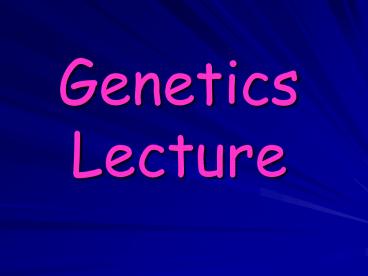Genetics Lecture PowerPoint PPT Presentation
1 / 34
Title: Genetics Lecture
1
GeneticsLecture
2
Part IDNA
3
DNA
DNA is a rather large molecule containing
nitrogen and phosphate
DNA is a polymer made from many thousands of
nucleotides strung together
4
Nucleotide
- It is made of a
- Deoxyribose (5 carbon Sugar)
- Phosphate group (PO4)
- Base (A,C,G,T)
5
- Nitrogenous base
- A single or double ring molecule containing
nitrogen - There are 4 different kinds
- Adenine (A)
- Thymine (T)
- Cytosine (C)
- Guanine (G)
6
Erwin Chargoff
- His research showed that in all the DNA he
studied the amount of Guanine (G) equaled the
amount of Cytosine (C) and the amount of A
amount of T
7
Rosalind Franklin
- Her X-ray Diffraction data showed that DNA was
organized as a helix
Photo 51
8
DNA structure
2 strands
2 or 3 strands?
9
James Watson Francis Crick
They guessed where to put the phosphates (on
the outside) and bases (on the inside)
10
Phosphates are on the outside,Bases are on the
inside
DNA Structure
Nucleotides are strung together Like beads on a
string
11
DNA Structure
The strands are held together by
Hydrogen bonds
12
DNA Structure
Pairs of bases form the rungs
Like a ladder The sugar phosphate backbone are
the rails
13
The sugar phosphate backbone looks like this
Phosphate Sugar phosphate Sugar phosphate sugar
Phosphate Sugar phosphate Sugar
-BASE -BASE -BASE -BASE -BASE
14
DNA Structure
Bases are hydrogen bonded to each other which
joins the two strands
Adenine can only H-bond to Thymine and Cytosine
can only H- bond to Guanine
Complementary Base Pairing
15
DNA Structure
Anti-parallel
16
Anti-parallel
-BASE -BASE -BASE -BASE -BASE
-BASE -BASE -BASE -BASE -BASE
Phosphate Sugar phosphate Sugar phosphate sugar
Phosphate Sugar phosphate Sugar
Phosphate Sugar phosphate Sugar phosphate sugar
Phosphate Sugar phosphate Sugar
17
Part II Chromosomes
18
Chromosomes
- Linear units of DNA
- Come in pairs (homologous pairs)
- Each species has characteristic number
- Number of chromosomes doesnt matter how
evolved a species is. - Bacteria do not have chromosomes
- they have circular pieces of DNA
19
Chromosome Anatomy
- Chromosomes come in two forms
- duplicated
- unduplicated
- Duplicated chromosomes are made up of two
chromatids - Referred to as sister chromatids
- Chromatids are joined at a region called the
centromere - Chromatids are identical
- Each chromatid is a double helix of DNA
20
(No Transcript)
21
Genes
- Functional units of DNA
- Code for proteins
- Humans have 20-25K genes
- Only 3 of genome contains genes
http//www.ornl.gov/sci/techresources/Human_Genom
e/faq/genenumber.shtml
22
Human Genome
- Refers to all the DNA in human cells
- Contains 3 Billion base pairs
- Sequencing (HGP) completed April 25th 2003
23
What is the Human Genome Project?
- The Human Genome Project (HGP) was an
international 13-year effort formally begun in
October 1990. - The project was planned to last 15 years, but
rapid technological advances accelerated the
completion to 2003. - Project goals were to determine the complete
sequence of the 3 billion DNA subunits (bases),
identify all human genes, and make them
accessible for further biological study.
http//www.ornl.gov/sci/techresources/Human_Genome
/faq/faqs1.shtmlgenetics
24
Karyotype
- Picture of a species chromosomes
25
Making a Karyotype
- First the chromosomes are stained
26
Making a Karyotype
- Then they are organized by height and centromere
location
27
Autosomes vs sex chromosomes
- Chromosome pairs 1- 22 are called Autosomes
- Chromosome pairs 23 are called the X and Y
chromosomes - Referred to as the Sex Chromosomes because they
contain genes which determine gender - Two Xs means you are genetically female
- One X and a Y means you are genetically male
- Presence of a Y chromosome means the person is
male
28
Male or Female?
29
Homologous Pairs
- You have two copies of every chromosome
- You received one from your mother
- Your received one from your father
- Homologous pairs have the same genes but not
always the same form of the gene - 23 pairs
- 23 x 2 46
30
Abnormal Karyotypes
- Too many or too few chromosomes is bad
- Trisomy means you have 3 copies of one chromosome
- Only viable for 13, 18, 21, X
- Monosomy means one chromosome is missing its pair
- Only viable for X or Y
- Both are caused by errors during Meiosis
31
Karyotype Nomenclature
- Total number of chromosomes
- The makeup of the sex chromosomes
- Any extra chromosomes
- Examples
- 46, XX
- 46, XY
- 47, XY, 21
32
Haploid Gametes
- In order to get one set of chromosomes from each
parent, their gametes had to contain only half
the normal number of cells - This is known as the haploid number
- The haploid number is
- half the total number of chromosomes
- the number of pairs
33
Haploid Vs Diploid
- The haploid number is half the total number of
chromosomes or the number of pairs - All non-sex cells contain the diploid number of
cells - The diploid number is the total number of
chromosomes
34
Gametes Zygotes
- Gametes are sex cells
- Egg cells
- Sperm cells
- All gametes are haploid
- When gametes join they form a zygote
- All zygotes are diploid

